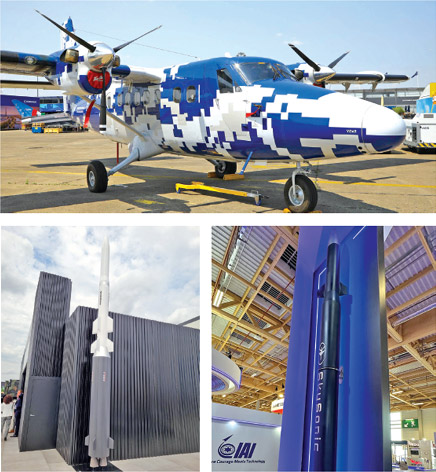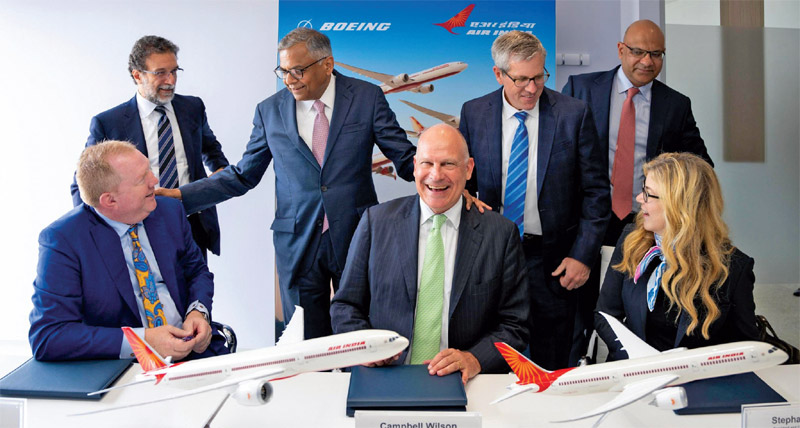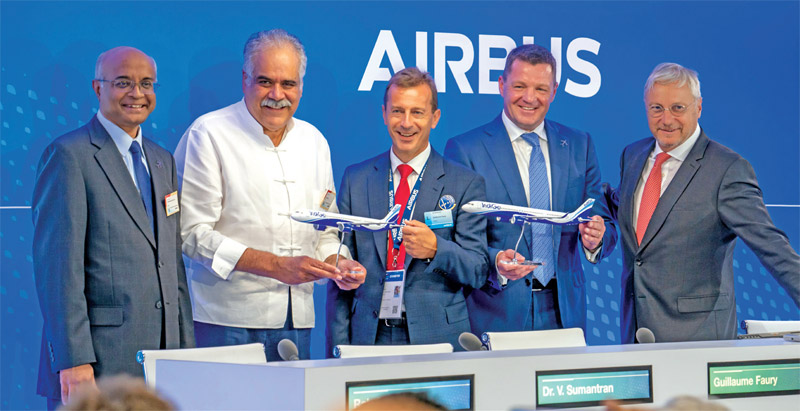Paris Air Show sees renewed optimism about the revival of the aviation sector
Prasun K. Sengupta
After a four-year hiatus because of Covid-19 pandemic restrictions, the 54th Paris Air Show held at the Le Bourget Airport from June 19 to 25 witnessed strong demands for both commercial airliners and new-generation air-defence systems. With air travellers returning after the pandemic and the strong demand for jetliners, airlines worldwide, especially Indian, are ordering new aircraft. Aircraft manufacturers, on the other hand, are struggling to keep up with the high demand, saying the supply chain will only stabilise in 2027 and beyond for general availability.

In the latter half of the first day at the expo, a record-setting contract was signed between Airbus and Indian airline IndiGo for 500 single-aisle airliners. It is the biggest single purchase agreement in the history of commercial aviation. Incredibly, these 500 A320neo family aircraft (exact models and engine choice are still to be decided) are all firm orders—a sign of the airline’s massive confidence in the Indian air travel market, which has already exceeded pre-Covid-19 levels. These bring the airline’s total Airbus backlog to over 1,330 aircraft, with the carrier all set to double in size by the end of the decade. The value of the contract is undisclosed according to Airbus, which has stopped publishing list-prices. The first deliveries will begin in 2030.
What is remarkable is that only two years ago, some had predicted that the pandemic would irrevocably change and halt the growth of air travel. The IndiGo order has proved that the pandemic is now well in the rear-view mirror. IndiGo presently operates more than 300 aircraft and it has previous orders for 480 aircraft, which are yet to be delivered. The Tata Group-owned Air India too firmed up its order for 250 Airbus aircraft and also selected an Airbus maintenance and digital package to power the airline’s transformation and growth strategy. The aircraft order includes 140 A320neo and 70 A321neo single-aisle aircraft as well as 34 A350-1000 and six A350-900 wide-body jetliners. Last February, the airline had signed a letter of intent to acquire these aircraft as well as Boeing-made airliners worth Rs 6.4 lakh crore.
On the second day of the expo, Air India inked a contract with Boeing for the delivery of 190 B.737 MAXs, 20 B.787 Dreamliners and 10 B.777Xs, with options for 50 B.737 MAXs and 20 B.787 Dreamliners—this being Boeing’s largest order in South Asia and highlights its 90-year partnership with Air India. Commenting on these contracts India’s civil aviation minister Jyotiraditya Scindia said: “India has set another landmark with this largest-ever recorded order by a carrier with any aircraft manufacturer in the world.” He expressed confidence that such investments would yield fruitful outcomes in terms of employment opportunities within India, adding that “every USD invested in civil aviation yields USD 3.1 in terms of new growth, as well as the employment multiplier. Every direct job in civil aviation results in 6.1 indirect jobs in the sector. And therefore, there are tremendous dividends that accrue from the ever-expanding civil aviation sector.”
De Havilland Aircraft of Canada (DHC) unveiled a new variant of its twin-turboprop short take off and landing (STOL) DHC-6 Twin Otter—the Classic 300-G—at the expo. The company has already secured purchase agreements and letters of intent for 45 examples of its fifth-generation Twin Otter. Aircraft leasing firm Jetcraft Commercial is the launch customer, taking the first 10 300-Gs with deliveries set to start next year. “For over 50 years, the DHC-6 Twin Otter has stood alone as the most reliable and versatile aircraft in its class,” commented DHC CEO Brian Chafe. “After extensive consultation with our customers, we are poised and proud to take this iconic aircraft to new heights with the new DHC-6 Twin Otter Classic 300-G.”
The DHC-6 Twin Otter Classic 300-G retains the rugged airframe of its predecessors but incorporates new Pratt & Whitney engine technology for enhanced performance. DHC said it has reduced the aircraft’s basic weight by 500 pounds, allowing for more payload or longer range. The Classic 300-G features a redesigned cabin interior and its flight deck features the Garmin G1000 NXi avionics suite and GFC 700 autopilot with envelope protection. Sales and letters of intent announced during the opening day of the show included 10 for India-based launch customer FlyBig. The Indian airline will use them to connect remote communities as part of India’s Udan regional airport development programme, part of a regional connectivity scheme for improving underserviced air routes and connecting Tier-2 and Tier-3 communities. Lessor Jetcraft Commercial also signed a purchase agreement for 10 of the new aircraft, which are likely to see service with operators in Nepal and the Maldives.
By choosing the Twin Classic 300-G, FlyBig has effectively revealed that there are no takers for the Do-228NG STOL commuter transport aircraft that is series-produced by state-owned Hindustan Aeronautics Ltd (HAL) but which does not possess an airworthiness certificate from either the US Federal Aviation Administration or the European EASA authority, which in turn means that no insurance company will be willing to provide hull insurance for the Do-228NGs.
The expo also marked the evolution of many international partnerships, including the growing relationship between India and Europe, as demonstrated by the presence of India’s delegation at Le Bourget. The delegation, comprising leaders from various sectors of India’s military-industrial complex, represented the country’s commitment to cross-continental collaboration. One such leader is Neeraj Gupta, the chairman of the Society of Indian Defence Manufacturers’ (SIDM) international and exports committee and managing director of MKU. “The India-Europe relationship is a driving force behind advancements in the global aerospace industry, and the Paris Air Show provides an ideal platform to showcase our capabilities,” said Gupta. “We are thrilled to leverage the opportunities to forge enduring partnerships and catalyse innovations that will shape the future of defence marketing.” The SIDM represents India’s military-industrial complex, promotes self-reliance, fosters collaborations and advocates for India’s military-industrial growth on the global stage. The MKU, headquartered in Kanpur, specialises in platform protection and optronics solutions. Collaborations with key European players in the aerospace industry, including Dassault Aviation, reinforce India’s commitment to advanced solutions for airborne platforms industry-wide.
Hypersonic Missiles
Military OEMs worldwide are racing to meet the demand for systems to protect against attacks using tricky-to-intercept hypersonic air-to-surface/surface-to-surface missiles, with several on display at the Paris Air Show. Flying at multiples of the speed of sound, “everything’s going faster, that’s what changes the game,” said Lionel Mazenq of the European missile-maker MBDA’s Future Systems division. “They change course. It’s hard to know whether they are coming towards you, it’s challenging to predict their behaviour,” he added, although the new missiles “can be intercepted, especially in the terminal stage” of their flight.
The MBDA also revealed that it had launched a three-year programme to develop an interceptor dubbed Aquila, with 19 partner-firms and 30 sub-contractors from 14 European countries–France, Germany, Italy, the Netherlands and Spain. The partner-firms include Spanish firm Sener and Germany’s Diehl Defence, with the latter already receiving €100 million for its own interceptor R&D project. Other partners on the project include the MBDA in France, Germany, Italy and Spain; France’s Roxel and ArianeGroup; Germany’s Bayern-Chemie and OHB; Italy’s Avio Aero; and the Netherlands’ GKN Fokker. Brussels is expected to chip in with €80 million (USD 87 million) from the European Commission.

But no MBDA interceptors are expected to fly before 2030. Some of the first trials by fire of hypersonic systems have come in Ukraine, where Kyiv said last May that it was able to shoot down a Russian Kinzhal hypersonic air-launched missile flying at over five times the speed of sound (6,000 kmph). Countering such attacks means combining a detection system with an interceptor missile that can itself reach hypersonic speeds. “We have to be more manoeuvrable than them, with gigantic speeds at the moment of intercept, more than 12,000 kmph,” Mazenq said. “The challenge is to defeat the threat in the altitude between 25 km and 75 km or 80km, the environment is totally different and most of the systems that exist today feel uncomfortable”
The MBDA and its partners will develop the Aquila concept for the European Defence Fund (EDF)-supported Hypersonic Defence Interceptor Study (HYDIS) project. The missile manufacturer’s HYDIS proposal is being awarded funding of €80 million (USD 87.5 million) without a call for proposals in the EDF’s 2023 work programme. MBDA officials expect to be on contract with Europe’s defence materiel agency OCCAR by the year’s end. HYDIS is set to compete with the Spanish-led HYDEF project. This is headed up by Sistemas de Misiles de España (Spanish Missile Systems)—a conglomerate of several Spanish defence companies—and includes Germany’s Diehl Defence and Nordic company Nammo. Both HYDEF and HYDIS are a component of the notional European Permanent Structured Cooperation (PESCO) project Twister—short for Timely Warning and Interception with Space-based TheatER. Twister is a multi-national project aimed at developing a European hypersonic air-defence system. The EC opted to double-source on the development of the interceptor because there was no counter-hypersonic missile capability available in Europe. HYDIS is entering the concept phase with three multi-stage interceptor architectures.
Two of the architectures to be studied are three-stage, one of which is air-breathing—possibly a ramjet like the Meteor beyond-visual-range air-to-air missile. The second is a conventional rocket-powered missile with a large booster, while the third is a two-stage weapon with booster. The programme will examine and select one of these options for further development at the end of the study. Some of the elements on the project are at a technology readiness level of one and need to be matured during the work. The hypersonic interceptor is only part of the European effort to develop the Twister system, however. The EDF is also funding a project called Odin’s Eye, supporting the initial development of an autonomous European early-warning capability supporting defence against ballistic missiles and hypersonic threats. The 24-month, €7.8 million study is being led by German satellite firm OHB. Selection of one of the two missiles is expected to follow after the studies. The second phase of development would then be launched and partly funded by the EDF, potentially enabling the first prototype missiles to be ready by 2030. However, the cost of a potential hypersonic system could be in billions, MBDA CEO Eric Beranger warned at the company’s March press conference in Paris.
Israel’s Rafael Advanced Defense Systems claimed at the expo that it will take an international lead in the development of an interceptor to tackle emerging hypersonic threats. Its two-stage SkySonic interceptor is being developed under the internal research and development funding. “This missile is one generation beyond David’s Sling,” said Pini Yungman, head of the Air Defence Division at Rafael. “It will take a few years to be ready with a system, but we are hoping that within the next few months we will move to full-scale development under a contract.”

SkySonic’s large booster is used to get the second stage kill-vehicle close to the target. The kill-vehicle will then manoeuvre and close in on the target such as glide vehicles or cruise missiles. “The challenge is not the speed, but the manoeuvrability of the threat. The second is the trajectory and altitude that the threat is flying in,” Yungman added. Rafael is not developing the radar that will be needed to track and update the interceptor with the target vehicle’s trajectory. But Yungman said his company will work with “friends and allies” on adapting existing radars to the task that will be augmented by optronic sensors. “We know how to adjust the sensors and to define the requirements in a way that it will fit to the next generation threat as well,” Yungman said. Rafael believes its SkySonic will be a component of a layered air and missile defence system, rather than a stand-alone system. The SkySonic joins other counter-hypersonic systems in development. The US Missile Defense Agency (MDA) is developing the Glide Phase Interceptor. The MDA has also upgraded the Raytheon SM-6 surface-to-air missile to intercept hypersonic glide-vehicles in the terminal phase, although the capability is unproven.
Other Developments
Diehl Defence showcased two new weapons designed for sixth-generation multi-role combat aircraft–including the Future Combat Air System (FCAS) being developed by a trio of European nations. The Future Combat Air-to-Air Missile (FCAAM) will be a direct descendant of the company’s IRIS-T short-range air-to-air missile. Diehl Defence also highlighted its new warhead-equipped Light Attack Remote Carrier design, although it stresses that this is not part of FCAS, where work in this area is being led by Airbus Defence & Space and MBDA. The 320kg weapon will be test-launched in 2024—either from an aircraft or more likely from a catapult—if further funding is allocated. Service entry is notionally in the 2030s.
China’s state-owned arms exporter CATIC unveiled a new and more powerful variant of the Wing Loong series of medium-altitude, long-endurance uncrewed aircraft systems (UAS) at the expo. A one-tenth-scale model of the WL-X concept was shown for the first time at the China National Aero-technology Import and Export Corporation’s (CATIC) booth. In comparison to the 4.2-metric ton WL-2 UAS currently in service, the WL-X features a new, high-aspect-ratio wing, extended forward fuselage, a new turboshaft and significantly greater weapons-carrying capacity. The features of the WL-X appear to correspond to the WL-3 concept that was unveiled at Airshow China last November.
The WL-3 was listed with a 6.2-metric tonne weight, with the capacity to carry up to 2.3 metric tonnes of weapons. The WL-3 also was described as having a 40-hour endurance—25 per cent better than the WL-2. An official from CATIC at the booth stated that the WL-X concept was being shown in Paris for the first time, but said that no further information is immediately available about the concept. The scaled model of the WL-X reveals the new wing, with the tapered section starting further outboard than the WL-2. The longer inboard section with greater width accommodates eight munitions on each wing, versus the provisions for five weapon stations on each wing of the WL-2. To carry the heavier load, the WL-X features a new engine with a five-bladed propeller, which includes two more blades than the engine that powers the WL-2. China has to date exported the WL-2 to at least seven countries, including Pakistan.
During the expo, HAL and Fabrica Argentina de Aviones (FAdeA) of Argentina signed an MoU to explore the possibilities of collaboration in the field of maintenance, repair and overhaul (MRO) and to meet any offset requirements in case of probable sale of HAL-made platforms (like the Tejas Mk.1/Mk.1A light multi-role combat aircraft) in the Latin American region. Indonesia, meanwhile, selected the Thales-developed Ground Master-400A air-defence radar, thereby putting to rest all speculation about the country opting for the ‘Arudhra’ S-band radar developed by India’s DRDO and built by Bharat Electronics Ltd. Jakarta will acquire 13 Ground Master-400As along with the SkyView command and control system. The SkyView system provides a 360-degree air surveillance picture based on data from the radar network and integrates air operating centres at the local, regional and national levels.

